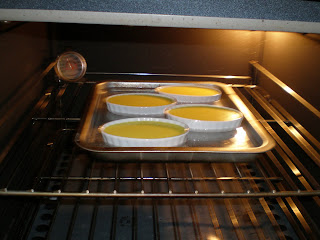Baking is closely related to chemistry. I like to think of it as the science you can eat. This post is going to be specifically about baked créme brûlée. Sort of recently it was Mother's Day and my mom requested that I make her créme brûlée. This dessert is basically a custard that is baked. Custards are a type of pudding that has about equal parts eggs and milk/cream.
If you would like to make some you will need ramekins, a pan deep enough to put water halfway up the ramekins and a butane torch.
1 cup heavy cream
1 cup milk
1/4 vanilla bean (split)
3 egg yolks
1 whole egg
1/4 cup sugar
brown sugar
cut up fruit and berries
Eggs provide a structure and color to the custard, while milk/cream provide flavor and texture. Both provide fat, which is essential for many desserts. Sugar provides flavor and little else in the custard. At the end sugar comes back to provide a lovely texture and fun activity.
The recipe I used called for a quarter of a vanilla bean to be steeped for 10 minutes in the milk/cream mixture after it had been brought to a boil on the stove. Eggs combined with sugar. Remove the vanilla bean and scrape the seeds into the milk/cream. Add the milk/cream to the eggs slowly. Strain the final mixture and dispense into ramekins. The ramekins then go into a pan with water in it (halfway up the ramekins) and into a 325˚F oven.
The water is to make sure the créme mixture cooks evenly and doesn't dry out. They bake for 25-30 minutes, are removed from the oven and allowed to cool in a refrigerator for 4 hours or more. The créme brûlée should be eaten within two days of baking.
To prepare for consumption remove the baked créme brûlée from the fridge and sprinkle either white sugar or brown sugar evenly on the top. Take a butane torch of some kind and caramelize the sugar on top. This should leave a hard brownish shell of sugar.
Place fresh fruit on top and dig in.
-Abby
 |
| Nom nom nom |





I ate one of those, and it was yummy!
ReplyDelete